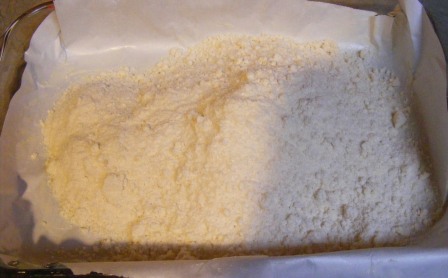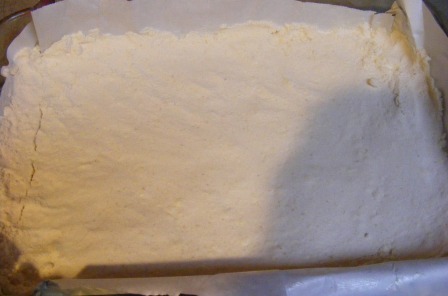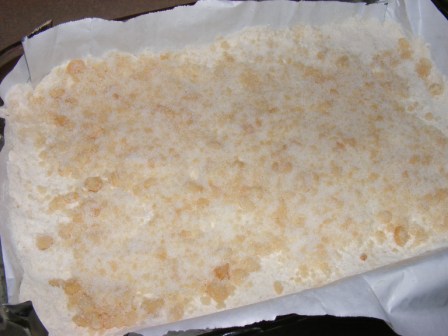
Today, we bring you a Modern Baker Challenge two-fer. One thing that I love about baking cookies, brownies, and bars is that it’s almost as easy to make two recipes as it is to just make one. In fact, growing up I don’t ever recall my Mom making just one type of cookie when she baked. And she still makes them in multiples to this day, as evidenced by the fact that she often shows up here with bags of Snickerdoodles, chocolate chips, and peanut butter cookies.
So it was not at all unusual for me to decide to bake Sour Cream Brownies and Caramel Crumb Bars from the Cookies, Bars & Biscotti section of The Modern Baker on the same day. In fact, I’ve baked a number of the cookie recipes in this section this way, even though I’ve blogged them separately. But there was just something about the way these two looked on a plate together that made me decide they wanted to be in the same post.
I started with the Sour Cream Brownies. Like the Cocoa Nib Brownies, these babies are loaded with bittersweet chocolate. Nick Malgieri says that the inclusion of the sour cream cuts back the sweetness just a bit and keeps the brownies moist, and I’d have to agree. These brownies are very rich, but not cloying; and they are moist and fudgy, even after a day or so in the fridge.
If you’ve ever struggled with melting chocolate over a pan of simmering water while holding a bowl and trying not burn your fingers, or attempted to melt it in the microwave without burning it, you’ll appreciate Nick’s technique for melting the chocolate in this recipe. I melted the 6 ounces of butter called for in the recipe in a saucepan and let it bubble for a few seconds. Then I removed the pan from the heat, dropped in the chocolate chunks, and shook the pan to submerge the chocolate in the hot butter. By the time I had mixed the brown sugar, eggs, sour cream, salt, and vanilla in the mixer, the chocolate was melted and ready to be whisked into the butter.

I stirred the chocolate mixture, and then the flour and walnuts, into the mixing bowl with a rubber spatula — another trick I learned from Nick. Overmixing the batter results in tough brownies and fallen cookies, so he recommends mixing in the last few ingredients, including the flour, by hand.
I spread the batter in the pan, smoothed the top, and sprinkled it with a few more walnuts.

I baked the brownies at 350°F for 30 minutes, and not a second more. They still looked very moist in the center, but that’s exactly how the recipe said they should look.

I set the brownies aside to cool. Cutting them would have to wait a day, as Nick also recommends refrigerating brownies overnight. This makes moist brownies like these easier to cut and intensifies the chocolate flavor.

While the brownies were baking, I mixed up the Caramel Crumb Bars. These bars are Nick’s favorite cookie, and I can see why. They consist of three layers — a buttery dough, caramel filling, and crumb topping. And yet they are surprisingly easy to make.
I began by mixing the dough in the mixer. It was made of butter, sugar, salt, vanilla extract, and flour, all mixed together to a soft, silky texture reminiscent of Scottish shortbread dough. I pressed 3/4 of the dough into the pan for the bottom crust. I put the pan in the refrigerator to chill and added a bit more flour to the remaining dough to make the crumb topping.

The next step was to make the caramel. Despite my previous issues with making caramel for semolina cake and pineapple tatin, I have since had better success with caramel, so I felt pretty good about making the filling for these bars. Besides, this caramel started with sweetened, condensed milk and light corn syrup, so I was halfway home before I ever began.

I put the milk and corn syrup into a pan with butter and dark brown sugar. I brought it to a low boil, then let it simmer for about 10 minutes, until the caramel was thick and had taken on just a little bit of color. I set the caramel aside to cool for a few minutes before assembling the bars.

I spread the caramel over the chilled dough, then sprinkled the crumbs on top.

By this time the brownies were finished baking, so I put the caramel bars into the oven, which was still set at 350°F. I baked the bars for 30 minutes, until the filling was a deep, caramel color and the topping had baked through.

I cooled the bars in the pan for about 20 minutes, then cut them. Because of the thick, gooey caramel, these bars are easier to cut when still slightly warm. And although the recipe says to cool them to room temperature before serving, I can attest that they are delicious when they are still a bit warm.

I can easily see why the caramel crumb bars are Nick’s favorites. The sweet, creamy caramel filling is out of this world, and it pairs nicely with the soft, buttery, slightly chewy crust. And of course, crumb topping goes well with almost any sweet. These are definitely on the repeat list. In fact, just writing this post has me thinking about making them to take to work tomorrow.
The brownies came out of the fridge moist and chewy. They were rich, dense, and oh-so-chocolatey. And of course, walnuts are a classic addition to brownies and gave these a nice crunch.
Having made a number of Nick’s brownie recipes, I am convinced that using real chocolate, rather than cocoa or chocolate chips, is the way to go for rich, moist brownies. The only thing I’m not sure of is whether I liked these brownies or the cocoa nibs ones better. I’ll probably have to make both of them together so I can do a side-by-side comparison. In the interest of baking science, of course.

















































